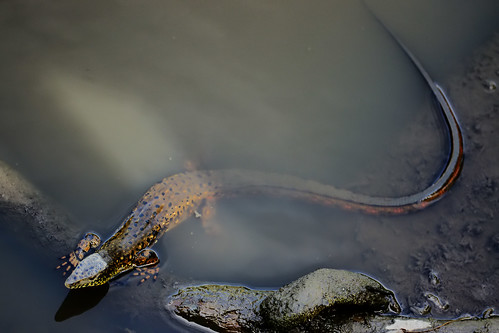Post by Ceratodromeus on Jun 25, 2015 0:56:55 GMT 5

Scientific classification
Kingdom: Animalia
Phylum:Chordata
Class: Reptilia
Order: Squamata
Family: Teiidae
Genus: Crocodilurus
Species: C. amazonicus
Description:
C. amazonicus is a large, semi- aquatic teiid. The head is green with black mottled coloration. Throat coloration is typically yellow.The eye is large, with a round pupil. The rest of the body is a mottled grey/ green combo action, with large yellow spots located down the animals' abdomen. Young animals typically have red coloration on their forelimbs and tail; adults too have this coloration, but it is less pronounced.The tail is compressed and elongated, and the legs are short but powerfully built to aid with aquatic locomotion. Sexual dimorphism does not appear to be present within the species. Females average roughly 190mm(7.4in) in snout-vent length, and a tail length of ~407mm(15.7in). Males average a snout-vent length of 187mm(7.3in) and ~401mm(15.7in)tail length.{1}
Geographic range & habitat:
This species is found in Colombia, Venezuela, French Guiana, Brazil, and Peru. The crocodile tegu can be found in close proximity to large bodies of water(I.e. rivers, lagoons, etc.). It can commonly be found basking on branches hanging over the water, and will jump in without hesitation if approached.

Dietary habits:
The crocodile tegu is an aquatic forager, and subsequently the prey taken is that of the aquatic variety. These lizards avoid competing for food resources with the sympatric Caiman lizard( D. Guinaensis) by having generalistic diet habits, feeding on Arthropods, crustaceans, fish, and anurans{2}while the caiman lizard is a specialized durophagous animal feeding almost entirely on molluscs.
Reproduction:
Mating occurs annually, with a typical clutch size being four or five eggs. Clutch size in comparison with other south american Teiids is small - those of the Tupinambis genus lay as many as twenty eggs.
References:
{1} Mesquita, Daniel O., et al. "At the water's edge: ecology of semiaquatic teiids in Brazilian Amazon." Journal of Herpetology 40.2 (2006): 221-229.
{2} Martins, Marcio. "Life in the water: Ecology of the jacarerana lizard, Crocodilurus amazonicus." The Herpetological Journal 16.2 (2006): 171-176.


